
Graphium sarpedon, the common bluebottle or blue triangle in Australia, is a species of swallowtail butterfly that is found in South and Southeast Asia, as well as eastern Australia. There are approximately sixteen subspecies with differing geographical distributions.
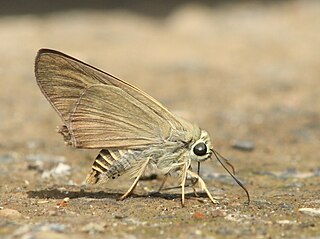
Badamia exclamationis, commonly known as the brown awl or narrow-winged awl, is a butterfly belonging to the family Hesperiidae. It is found in south and southeast Asia, Australia, and Oceania.

Hyarotis adrastus, the tree flitter, is a butterfly belonging to the family Hesperiidae found in South Asia and Southeast Asia.
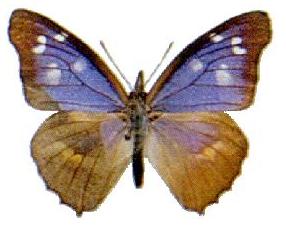
Libythea geoffroy, the purple beak, is a butterfly found in parts of India and Myanmar that belongs to the subfamily Libytheinae of the family Nymphalidae.

Myconita is a genus of moths in the family Gelechiidae.
Ornativalva is a genus of moths in the family Gelechiidae.
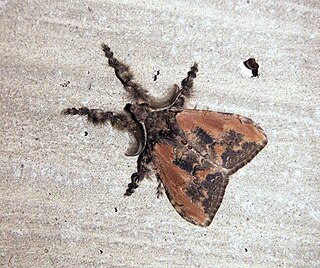
Olene mendosa, the brown tussock moth or hairy tussock moth, is a moth of the family Erebidae. The species was first described by Jacob Hübner in 1823. It is found in India, Bangladesh, Sri Lanka, Indonesia, Taiwan, Thailand and Australia.

Noctua fimbriata, the broad-bordered yellow underwing, is a moth of the family Noctuidae. It is found in Europe, North Africa, Anatolia, the Caucasus, Turkey, Caucasus, Transcaucasia, Armenia, Turkmenistan and Novosibirsk Oblast. The border of its southern range is unclear because of the similar looking species Noctua tirrenica.

Thysanoplusia orichalcea, the slender burnished brass, is a moth of the family Noctuidae. The species was first described by Johan Christian Fabricius in 1775. It is a polyphagous pest of vegetable crops that originated in Indonesia, from where it spread to Europe, South Asia, India, Sri Lanka, Africa, Australia and New Zealand. In northern Europe it is a migrant species.

Ptyoptila is a monotypic moth genus of the family Oecophoridae described by Alfred Jefferis Turner in 1946. Its only species, Ptyoptila matutinella, was described by Francis Walker in 1864. It is found in Australia, where it has been recorded from Queensland, New South Wales, the Australian Capital Territory and Victoria.

Eudesmeola is a monotypic moth genus of the family Erebidae erected by George Hampson in 1926. Its only species, Eudesmeola lawsoni, or Lawson's night moth, was first described by Felder and Rogenhofer in 1874. It is found in the dry inland areas of Australia.

Grammodes stolida, the geometrician, is a moth of the family Erebidae. The species was first described by Johan Christian Fabricius in 1775. It is found in Africa, southern Europe, most of Asia and Australia. It migrates to central and northern Europe as far north as England, Denmark and Finland.

Eudocima phalonia, the common fruit-piercing moth, is a fruit piercing moth of the family Erebidae. The species was first described by Carl Linnaeus in his 1763 Centuria Insectorum. It is found in large parts of the tropics, mainly in Asia, Africa and Australia but introduced into other areas such as Hawaii, New Zealand and the Society Islands. It is one of major fruit pests in the world.
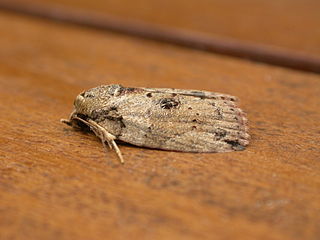
Nanaguna breviuscula, the pigeonpea pod borer, is a moth species of the family Nolidae. It is found from Sri Lanka and India east to Samoa. In Australia it is found in the Kimberleys in Western Australia, the northern part of the Northern Territory and from the Torres Strait Islands and Queensland to Sydney in New South Wales.

Calyptra minuticornis, the vampire moth, is a moth of the family Erebidae. It has been found in Indonesia, Java, India, Sri Lanka, and Australasia.

Helcystogramma hibisci is a moth in the family Gelechiidae. It was described by Stainton in 1859. It is known from China, Taiwan, India, Thailand, Vietnam, Sri Lanka, Indonesia and Australia, where it has been recorded from the Northern Territory and Queensland.
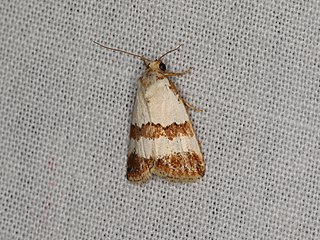
Maliattha ritsemae is a moth of the family Noctuidae. It was described by Samuel Constantinus Snellen van Vollenhoven in 1880. It is found on Sulawesi, Ambon Island, as well northern Australia and New Hebrides.
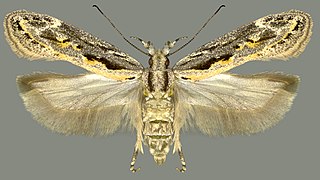
Ornativalva plutelliformis is a moth of the family Gelechiidae. It was described by Staudinger in 1859. It is found from southern Europe and North Africa east to western Asia and China (Xinjiang).
Myconita lipara is a moth in the family Gelechiidae. It was described by John David Bradley in 1953. It is found in Fiji.
Erechthias beeblebroxi is a moth of the family Tineidae. It is endemic to Australia, where it has been recorded from Queensland.

















